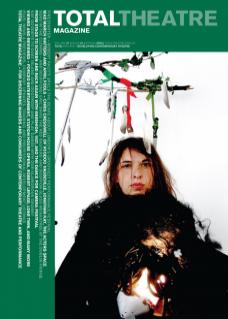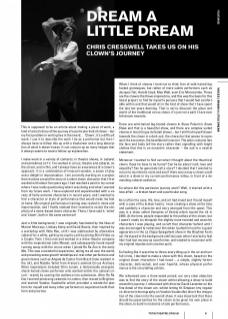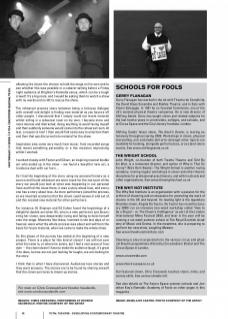This is supposed to be an article about making a piece of work, a kind of artist’s diary of the journey of a particular kind of clown – but my first problem in writing lies in that word... ‘Clown’, it’s a difficult word, I use it to describe the work I do as a performer but then I always have to follow this up with a disclaimer and a long description of what it doesn’t mean. It can conjure up so many images that it always seems to need a follow-up explanation.
I make work in a variety of contexts: in theatre shows, in cabaret and sometimes on TV. I’ve worked in circus, theatre and cabaret, on the street, and in film, and I always have an awareness of a clown’s approach. It is a combination of innocent wonder, a sense of play and a delight in improvisation. I am currently working on a project that revolves around the story of a silent clown character that I first worked with about five years ago. I had reached a point in my career where I was really questioning what I was doing and what I wanted from my future work. I have explored and experimented with a variety of fairly extreme characters in recent years, and I wanted to find a character or style of performance that would make me feel at home. My original performance training was rooted in mime and improvisation, and I finally realised that I wanted to revisit the simplicity of a mime-based clown character. There, I have said it, ‘mime’ and ‘clown’, both in the same sentence!
Just a little background, I was originally fascinated by the likes of Marcel Marceau, Lindsay Kemp and David Bowie, then inspired by a workshop with Nola Rae, until I was sidetracked by alternative cabaret for a while, getting my equity card by joining Skint Video as a Cryptic Twin. I then met and worked in a mime-theatre company with the inspirational John Mowat, and subsequently found myself running away with the circus when I joined Ra Ra Zoo in the early 90s. This was a wonderful experience, taking me all over the world, and provoking some great friendships as I met other performers and great clowns such as Angela de Castro from Brazil (now resident in the UK), and Natalie Tarlet from France’s seminal Circus Archaos. Other inspirations included Chris Lynam, a fantastically energetic shock-haired clown-performer who worked within the cabaret cir- cuit – mainly by scaring the audience into submission. After Ra Ra Zoo I started producing cabarets in London, then moved to Brighton and started Voodoo Vaudeville which provided a wonderful plat- form for myself and many other performers to experiment with their form and practice.
When I think of clowns I tend not to think first of wild-haired big- footed grotesques, but rather of more subtle performers such as Jacques Tati, Harold Lloyd, Max Wall, even Eric Morecambe. These are the clowns that have inspired me, and this was the basis for this latest project: to find for myself a persona that I would feel comfort- able within and that would sit in the kind of show that I have spent the last ten years devising. That is not to discount the place and worth of the traditional circus clown, it’s just not a path I have ever felt drawn towards.
There are wild-haired big-footed clowns in Slava Polunin’s Snow Show and that is a beautiful show, and there are complex suited clowns in most Cirque de Soleil shows – but I still find myself drawn towards the clown in a dark suit, the character that seems to represent the everyman, the bewildered innocent. The plain costume lets the face and body tell the story rather than signalling with bright clothes that this is an eccentric character – the suit is a neutral statement.
Moreover I wanted to find out what I thought about the theatrical clown. Does he have to be funny? Can he be about truth, love and empathy? Can he genuinely tell a story? I decided that I wanted to return to my mimetic roots and see if there was a way a clown could exist in a show in my current performance milieu, in front of a demanding cabaret audience.
So where did this particular journey start? Well, it started with a love affair – a broken heart and a particular song.
As is often the case, life, love, and art had mixed and I found myself with a case of the broken hearts. I was creating a show at the time, and suddenly a character and story emerged from this upset. This was in a show called Vampires of Variety which toured the UK in 2005. At the time, people responded to the pathos of the clown, but I wasn’t ready to relinquish the slightly more twisted and anarchic characters I was playing, and so left that character behind until I was encouraged to rediscover him when I pulled him out for a guest appearance in the La Clique Spiegeltent show in the Brighton Festival. He stayed in the background until last year when I started to feel like I had lost my way as a performer, and needed to reconnect with my original impulse and creative spirit.
So feeling like it was time to throw everything up in the air and turn full circle, I decided to make a show with this clown, based on the original clown characters I had loved – a simple, slightly forlorn character, dark-suited, and ever hopeful, whose physical performance is the storytelling vehicle.
We rehearsed over a three-week period; our very clear objective was to find the story of the clown whilst allowing a show to build around his journey. I rehearsed with director David Lavender on the fine detail of the clown act, whilst letting Kt Simpson (my regular co-director/choreography on Voodoo Vaudeville) direct the integration of the clown into the overall show. It was important that there should be opportunities for the clown to be given his own place in the show, to build in moments of solo performance, allowing the clown the chance to hold the stage on his own and to see whether this was possible in a cabaret setting before a Friday night audience at Brighton’s Komedia venue, which can be a tough crowd! It’s a big room, and I would be asking them to watch a show with no words and no MC to rescue the show.
The rehearsal process veers between being a tortuous dialogue with oneself and delight in finding new material as you bounce off other people. I discovered that I simply could not invent material whilst sitting in a rehearsal room on my own, I became more and more morose and distracted, doing anything to avoid facing myself and then suddenly someone would come into the rehearsal room. At last, a reason to live! I then would find some way to entertain them and then that quickly turned into material for the show.
Inspiration also came very much from music: from recorded songs that meant something personally, or a live musician improvising whilst I worked.
I worked closely with Foster and Gilvan, an inspiring musical double act who ended up in the show – we found a beautiful new act, a trombone duet with car horn...
So I had the beginning of the story using my personal history as a source and found whenever we were stuck for the next part of the story we would just look at what was happening in our personal lives and find the clues there, it was a story about love, and every- one has a story about love. As more performers joined the process, so we invented scenarios that the clown could weave in and out of, and this created new material for other performers.
For instance, Kt Simpson and Gil Cohen found the beginnings of a delightful double act when Gil, who is a new performer just discovering her clown, was desperately trying and failing to hoist herself onto the stage. Moments like these, invented in the last days of rehearsal, were what the whole process was about and will form the basis for future material, when we come to make the whole show.
So this phase of the journey has ended at the beginning of a new project. There is a place for this kind of clown! I am still not sure what his name is, or where he exists, but I feel a real sense of freedom – the clown doesn’t have to make the audience laugh, it’s great if he does, but we are not just looking for laughs, we are looking for the story.
I think that is what I have discovered. Audiences love stories and they want answers. The stories are to be found by sharing oneself. And the clown just loves to dream up stories.
Schools For Fools
Gerry Flanagan
Gerry Flanagan has worked in the UK with Theatre de Complicite, the David Glass Ensemble and Bubble Theatre; and in Italy with Clown Selvaggio. In 1991 he co-founded Commotion, one of the UK’s seminal physical theatre companies. He is now director of Shifting Sands. Gerry has taught clown and related subjects for the last twelve years in universities, colleges, and schools, and at Circus Space and the City Literary Institute, London.
Shifting Sands’ latest show, The Devil’s Doctor, is touring extensively throughout spring 2009. Workshops in clown, physical storytelling, and commedia dell-arte (amongst other topics) are available for booking, alongside performances, or as stand-alone events. See www.shiftingsands.co.uk
The Wright School
John Wright, co-founder of both Trestle Theatre and Told By An Idiot, is a renowned director, and author of Why is That So Funny? (Nick Hern Books). The Wright School is another roving academy, running regular workshops in clown and other theatre disciplines for professional practitioners, and within schools and other organisations. See www.thewrightschool.co.uk
The Why Not Institute
The Why Not Institute is an organisation with a passion for the artform of clowning and an obsession for promoting the work of clowns in the UK and beyond. Its leading light is the legendary Brazilian clown, Angela De Castro. De Castro has recently (Janu- ary 2009) run an intensive two-week workshop called ‘How to be a Stupid – or, The Clown’s Intelligence’ as part of the London International Mime Festival 2009, and later in the year will be running a six-week summer school at The Royal Scottish Academy of Music and Drama. In the meantime, she is preparing to perform her new show, Laughing Matters.
See www.thewhynotinstitute.com
Clowning is also incorporated into the various circus and physical theatre programmes offered by Circomedia in Bristol and The Circus Space in London.
www.circomedia.com
www.thecircusspace.co.uk
Our featured clown, Chris Cresswell, teaches clown, mime, and variety skills. For more on Chris Cresswell and Voodoo Vaudeville, see www.voodoovaudeville.com
See also details on The Actors Space summer schools and Jon- athan Kay’s Nomadic Academy of Fools on other pages in this magazine.
For more on Chris Cresswell and Voodoo Vaudeville, see www.voodoovaudeville.com


